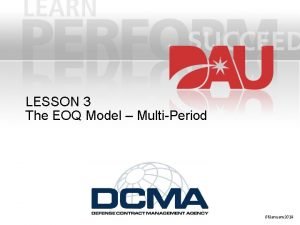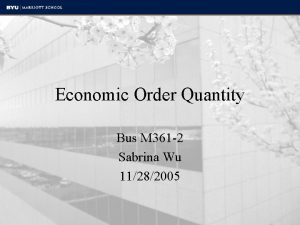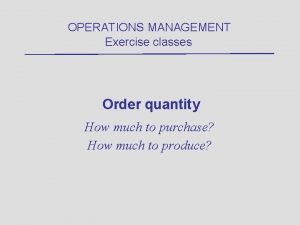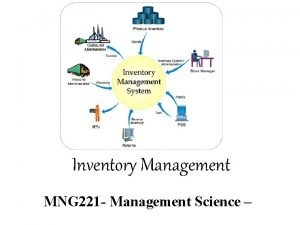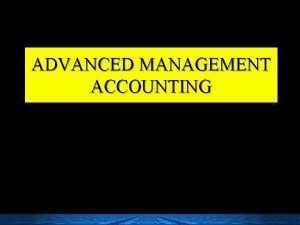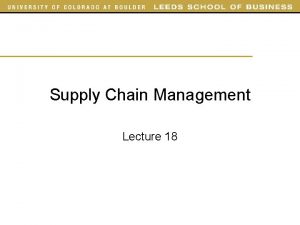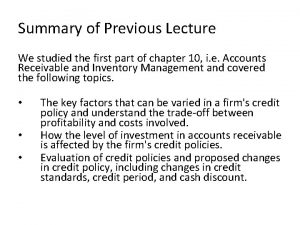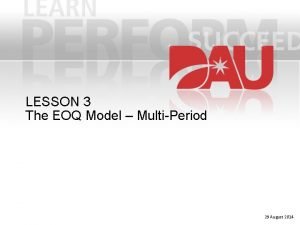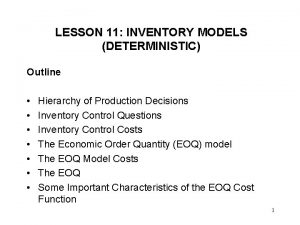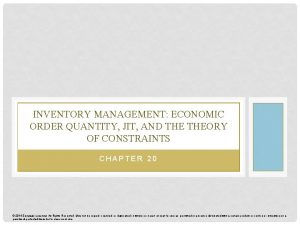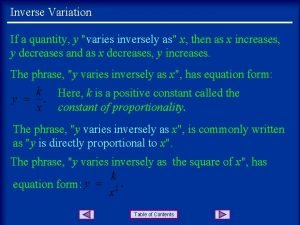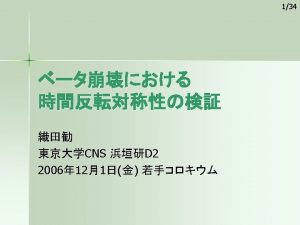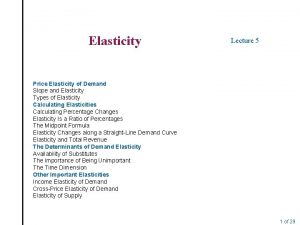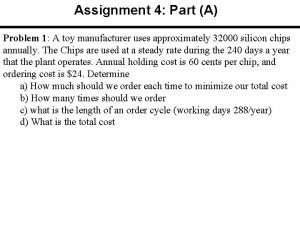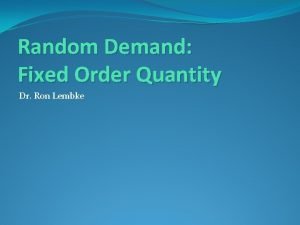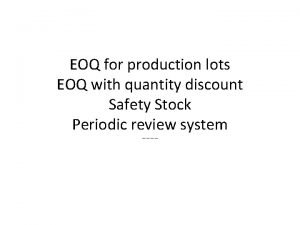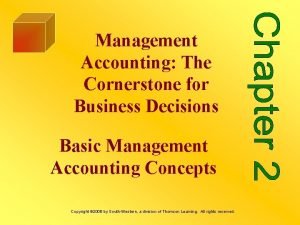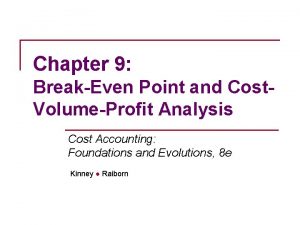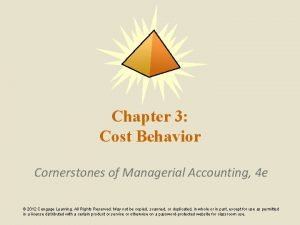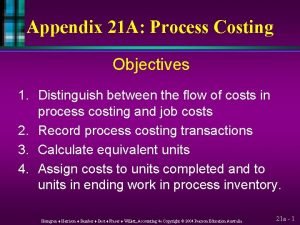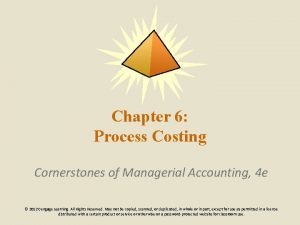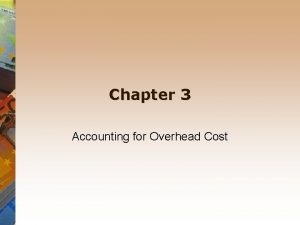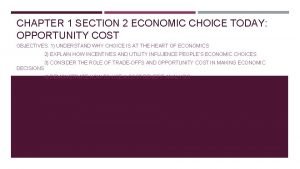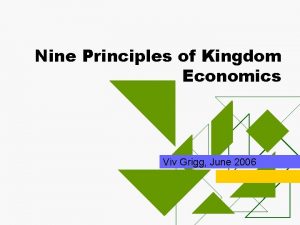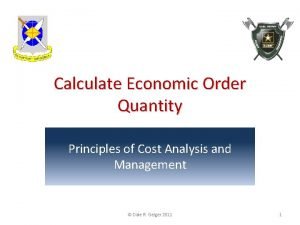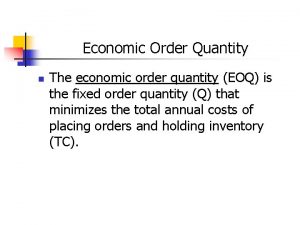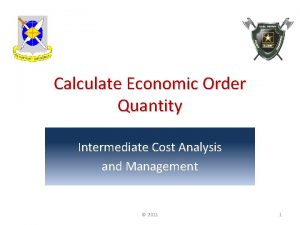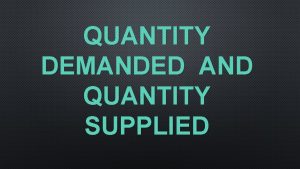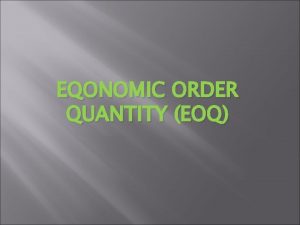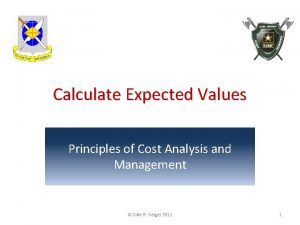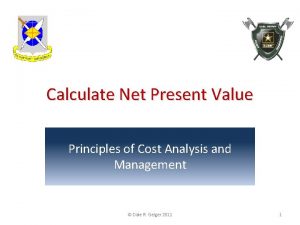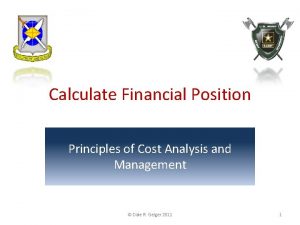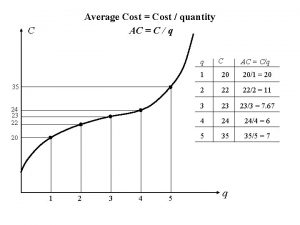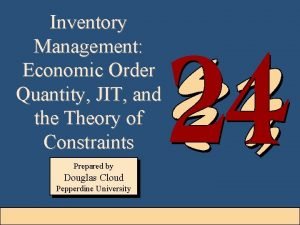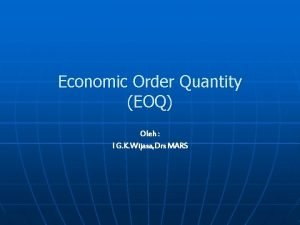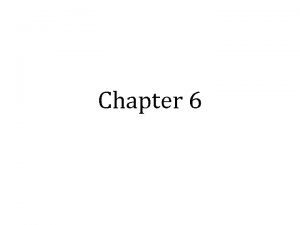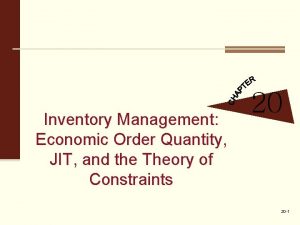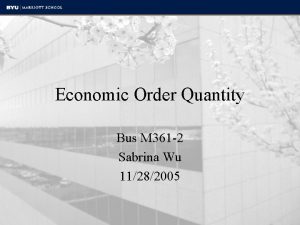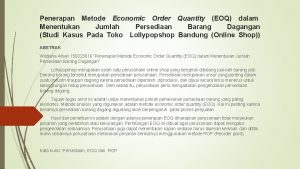Calculate Economic Order Quantity Principles of Cost Analysis



















































- Slides: 51

Calculate Economic Order Quantity Principles of Cost Analysis and Management 10. 4 1

What do you think? Corporal O’Reilly, the supply clerk, knows that it costs the Army money to generate a purchase order. To save money he proposes ordering the five years’ worth of ammunition at once. 2

Terminal Learning Objective Action: Calculate Economic Order Quantity Condition: FM Leaders in a classroom environment working as a member of a small group, using doctrinal and administrative publications, self-study exercises, personal experiences, practical exercises, handouts, and discussion. Standard: With at least 80% accuracy, you must: • Determine Batch Quantity Concepts • Apply Batch Cost Example • Determine Batch Quantity Concepts • Applying Holding Cost Example • Optimizing Order Quantity 3

Determine Batch Quantity Concepts • 4

Batch Cost Assumptions • Annual demand for units produced in batches is known • Every batch is the same size • i. e. same quantity of units produced 5

Batch Costs • 6

Batch Costs (Cont. ) • 7

Batch Costs (Cont. ) • 8

Batch Costs (Cont. ) • 9

Batch Costs (Cont. ) • 10

Batch Costs (Cont. ) • 11

Batch Costs (Cont. ) • Regardless of how you look at it: • More units in a batch mean fewer batches • Fewer batches mean lower Batch costs 12

LSA #1 Check on Learning Q 1. How does batch cost per unit change as batch size increases? A 1. Q 2. What are the key assumptions in batch quantity tradeoffs? A 2. 13

LSA #1 Summary 14

Apply Batch Cost Example • Purchasing supplies is a common example of a Batch cost • Each purchase order issued costs the organization $250 • Demand for supplies is 200 units 15

Batch Cost Example (Cont. ) • How much is purchasing cost if a separate purchase order is issued for each unit of supplies? 200 purchase orders * $250/ purchase order = $50, 000 • How much is purchasing cost if all 200 units are purchased using a single purchase order? 1 purchase order * $250/ purchase order = $250 16

Batch Cost Example (Cont. ) • 17

Batch Cost Example (Cont. ) • 18

Graph of Purchasing Cost $ X-Axis = Number of units per purchase order or batch As number of units per PO or batch increases, purchasing cost decreases 19

Questions to Consider • Using only this information for your decision, how many units should be ordered per purchase order? • Similarly, what savings might be achieved by training all of the soldiers needed for a particular task in one large group? • What else should be considered? 20

LSA #2 Check on Learning Q 1. How would you describe the graph of batch cost? A 1. 21

LSA #2 Summary • In this block, we’ve discussed Batch Costs while providing an example. 22

Determine Batch Quantity Concepts • Certain costs increase as quantity per purchase order increases • Inventory ties up cash and must be stored and maintained • Spoilage and obsolescence can occur • Time value of money – cash paid now is worth more than cash paid later • “Just in Time” ordering minimizes these “Holding Costs” 23

Questions to Consider • What might be the “holding costs” involved with training all of the soldiers required for a particular task in one large group or “batch”? 24

Holding Cost Assumptions • Annual Holding Cost is linear or variable on a per-unit basis • Units produced or purchased in batches are consumed or sold uniformly throughout the period 25

Holding Costs • Holding cost = $Holding Cost/Unit * Avg. #Units in Inventory • Average #Units in Inventory = #Units per Purchase Order/2 • Assumes Inventory is consumed uniformly throughout the year 26

Graph of Inventory Assumption (Cont. ) Inventory Level 60. 00 50. 00 40. 00 50 Units produced or purchased per batch 30. 00 20. 00 10. 00 X axis represents time 27

Graph of Inventory Assumption (Cont. ) 60. 00 Inventory Level 50. 00 40. 00 30. 00 25. 00 20. 00 10. 00 Units Consumed or Sold uniformly until all Inventory is gone 28

Graph of Inventory Assumption (Cont. ) Inventory Level 60. 00 50. 00 Average Inventory is 50/2 or 25 Units 40. 00 30. 00 25. 00 Average Inventory 20. 00 10. 00 X axis represents time 29

LSA #3 Check on Learning Q 1. What are the underlying assumptions related to holding costs? A 1. Q 2. How is average inventory calculated? A 2. 30

LSA #3 Summary • During this discussion, we spoke of Holding Costs and assumptions, as well as graphed it out for learning reinforcement. 31

Applying Holding Cost Example • Annual holding cost for supplies is $50 per unit • What is holding cost if each unit of supplies is purchased on its own purchase order? • Average inventory = 1 unit/2 or ½ unit • ½ unit * $50/unit = $25 • What is holding cost if all 200 units of supplies are purchased on one purchase order? • Average inventory = 200 units/ 2 or 100 units • 100 units * $50/unit = $5, 000 32

Holding Cost Example • Annual holding cost for supplies is $50 per unit • What is holding cost if each unit of supplies is purchased on its own purchase order? • Average inventory = 1 unit/2 or ½ unit • ½ unit * $50/unit = $25 • What is holding cost if all 200 units of supplies are purchased on one purchase order? • Average inventory = 200 units/ 2 or 100 units • 100 units * $50/unit = $5, 000 33

Holding Cost Example • Annual holding cost for supplies is $50 per unit • What is holding cost if each unit of supplies is purchased on its own purchase order? • Average inventory = 1 unit/2 or ½ unit • ½ unit * $50/unit = $25 • What is holding cost if all 200 units of supplies are purchased on one purchase order? • Average inventory = 200 units/ 2 or 100 units • 100 units * $50/unit = $5, 000 34

Graph of Holding Cost $ When quantity per purchase order is 10 Average Inventory = 5 and holding cost is $250 When quantity per purchase order is 100 Average Inventory = 50 and purchasing cost is $2, 500 X-Axis = Number of units per purchase order As number of units per purchase order increases, holding cost increases 35

LSA #4 Check on Learning Q 1. How does holding cost change as batch quantity changes? A 1. Q 2. How is holding cost represented on the graph? A 2. 36

LSA #4 Summary • Again, during this discussion, we spoke of Holding Costs examples, as well as a graphic representation for learning reinforcement. 37

Optimizing Order Quantity • Total Costs Related to Order Quantity = Purchasing Cost + Holding Cost • What is Total Cost when Quantity per order is 10 units? 5000 + 250 = 5250 • What is Total Cost when Quantity per order is 100 units? 500 + 2500 = 3000 38

Optimizing Order Quantity (Cont. ) • Total Costs Related to Order Quantity = Purchasing Cost + Holding Cost • What is Total Cost when Quantity per order is 10 units? 5000 + 250 = 5250 • What is Total Cost when Quantity per order is 100 units? 500 + 2500 = 3000 39

Optimizing Order Quantity (Cont. ) • Total Costs Related to Order Quantity = Purchasing Cost + Holding Cost • What is Total Cost when Quantity per order is 10 units? 5000 + 250 = 5250 • What is Total Cost when Quantity per order is 100 units? 500 + 2500 = 3000 40

Graph of Total Costs Total Cost is minimized where Purchasing Cost = Holding Cost ≈45 X-Axis = Order quantity in units 41

Optimizing Order Quantity (Cont. ) • Total Cost is minimized at the order quantity where Holding Cost = Purchasing Cost • Computation of this “Indifference Point” requires calculus beyond the scope of this course 42

Optimizing Order Quantity (Cont. ) • 43

Calculating EOQ • 44

LSA #5 Check on Learning Q 1. What are three variables used in the Economic Order Quantity formula? A 1. Q 2. How will EOQ change if holding cost per unit increases while all other variables remain the same? A 2. 45

LSA #5 Summary • In this lesson, we spoke of Optimizing Order Quantity, provided a graphic representation, and solved for the EOQ. 46

TLO Check on Learning 47

TLO Summary Action: Calculate Economic Order Quantity Condition: FM Leaders in a classroom environment working as a member of a small group, using doctrinal and administrative publications, self-study exercises, personal experiences, practical exercises, handouts, and discussion. Standard: With at least 80% accuracy, you must: • Determine Batch Quantity Concepts • Apply Batch Cost Example • Determine Batch Quantity Concepts • Applying Holding Cost Example • Optimizing Order Quantity 48

TLO Summary 49

Practical Exercises 50

Batch Quantity Spreadsheet Enter batch cost, holding cost, and demand into the spreadsheet to generate the graph of total cost © Dale R. Geiger 2011 51
 How to calculate economic order quantity
How to calculate economic order quantity How to calculate economic order quantity
How to calculate economic order quantity Quantity discount model in operations management
Quantity discount model in operations management Eoq formula
Eoq formula The theory of constraints
The theory of constraints Economic order quantity
Economic order quantity Economic order quantity
Economic order quantity Eoq formule
Eoq formule Economic order quantity formula
Economic order quantity formula Limitations of economic order quantity
Limitations of economic order quantity Examples of vector quantities
Examples of vector quantities Scalar and vector quantities
Scalar and vector quantities Why speed is a scalar quantity
Why speed is a scalar quantity Vary inversly
Vary inversly Scalar vector tensor
Scalar vector tensor Job order costing vs process costing
Job order costing vs process costing 1st order 2nd order 3rd order neurons
1st order 2nd order 3rd order neurons How to calculate real gdp from price and quantity
How to calculate real gdp from price and quantity How to calculate elasticity of demand
How to calculate elasticity of demand Economic batch quantity definition
Economic batch quantity definition Economic production quantity formula
Economic production quantity formula 32000/240
32000/240 The relative proportion of variable fixed or mixed
The relative proportion of variable fixed or mixed Fixed order quantity vs fixed time period
Fixed order quantity vs fixed time period Eoq for production lots
Eoq for production lots Production order quantity model example
Production order quantity model example Economic growth vs economic development
Economic growth vs economic development Economic growth vs economic development
Economic growth vs economic development Economic systems lesson 2 our economic choices
Economic systems lesson 2 our economic choices How to calculate prime cost
How to calculate prime cost How to calculate cost of goods transferred out
How to calculate cost of goods transferred out Cvp graph
Cvp graph How to calculate fixed cost
How to calculate fixed cost Calculate the cost per equivalent unit of conversion
Calculate the cost per equivalent unit of conversion Managerial accounting chapter 6
Managerial accounting chapter 6 Overhead cost per unit
Overhead cost per unit Structural steel fabrication cost estimation xls
Structural steel fabrication cost estimation xls Economic choice today opportunity cost
Economic choice today opportunity cost Five kingdom economic principles
Five kingdom economic principles Cost accumulation and cost assignment
Cost accumulation and cost assignment Cost accumulation and cost assignment
Cost accumulation and cost assignment Manufacturing cost vs non manufacturing cost
Manufacturing cost vs non manufacturing cost Job costing with process costing
Job costing with process costing Flotation cost in cost of equity
Flotation cost in cost of equity Cost concept and classification
Cost concept and classification Cost pools
Cost pools Manufacturing cost vs non manufacturing cost
Manufacturing cost vs non manufacturing cost Standard cost variance
Standard cost variance Flotation cost in cost of equity
Flotation cost in cost of equity Cost accumulation and cost assignment
Cost accumulation and cost assignment Cost control and cost reduction difference
Cost control and cost reduction difference Characteristics of standard costing
Characteristics of standard costing
